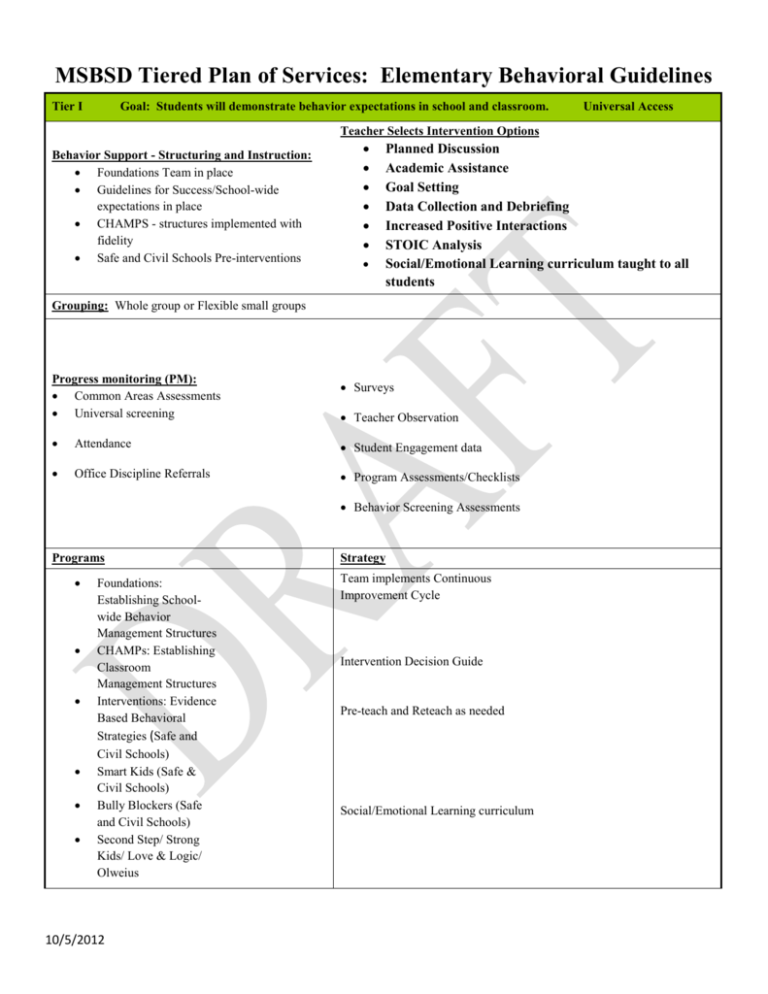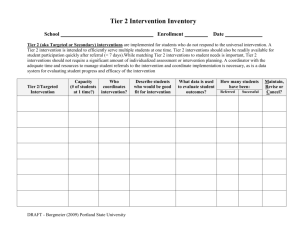PBIS Elementary Behavior
advertisement

MSBSD Tiered Plan of Services: Elementary Behavioral Guidelines Tier I Goal: Students will demonstrate behavior expectations in school and classroom. Universal Access Teacher Selects Intervention Options Behavior Support - Structuring and Instruction: Foundations Team in place Guidelines for Success/School-wide expectations in place CHAMPS - structures implemented with fidelity Safe and Civil Schools Pre-interventions Planned Discussion Academic Assistance Goal Setting Data Collection and Debriefing Increased Positive Interactions STOIC Analysis Social/Emotional Learning curriculum taught to all students Grouping: Whole group or Flexible small groups Progress monitoring (PM): Common Areas Assessments Universal screening Surveys Attendance Student Engagement data Office Discipline Referrals Program Assessments/Checklists Teacher Observation Behavior Screening Assessments Programs Foundations: Establishing Schoolwide Behavior Management Structures CHAMPs: Establishing Classroom Management Structures Interventions: Evidence Based Behavioral Strategies (Safe and Civil Schools) Smart Kids (Safe & Civil Schools) Bully Blockers (Safe and Civil Schools) Second Step/ Strong Kids/ Love & Logic/ Olweius 10/5/2012 Strategy Team implements Continuous Improvement Cycle Intervention Decision Guide Pre-teach and Reteach as needed Social/Emotional Learning curriculum Tier II Goal: Students will demonstrate behavior expectations in school and the classroom. Strategic Team Selects Intervention Options Interventions are implemented based on a systematic procedure that identifies students who are non-responsive to Tier I Instructional Strategies: Students continue Tier I instruction and programs/strategies Parents involved in process Accommodations made to increase student’s chance of success Interventions selected and implemented based on individual student needs. Grouping: Needs-based targeted grouping: whole group, small group, pullout Check In/Check Out Social/Emotional Learning (small groups) Positive Peer Reporting System Self-monitoring and Self-evaluation Home/School Note Behavior Contracting Class Pass Students regularly regrouped as needs change Progress monitoring): Continue Tier I progress monitoring Progress monitoring on Tier II interventions selected by the team Progress Monitoring (minimum of every two weeks) Programs Grade Target area Programs Grade Target area Interventions: Evidence Based Behavioral Strategies (Safe and Civil Schools) K-8 Motivation & Behavior Check In/Check Out K-5 Relationship support Common Classroom Problems Second Step (small group) K-5 Social Skills Training The Teacher’s Encyclopedia of Behavior Management (Safe and Civil Schools) K-8 Smart Kids (Safe & Civil Schools) – in small groups K-1 Social Skills Training Strong Kids (small group) 1-5 Social Skills Training Bully Blockers (Safe and Civil Schools) – in small groups 1-5 Bullying Stop & Think (Project Achieve) PK-5 Social Skills Training Tier III Goal: Students will demonstrate behavior expectations in school and the classroom Intensive Team Selects and Implements Intervention Options: Interventions are highly individualized and selected/implemented based on non-responsiveness to Tier II coupled with presenting needs determined by the team. Instructional Strategies: Student participates in Tier I plus Tier II plus Tier III Interventions are based on student needs Students needing Tier III interventions may benefit from services provided by outside agencies. 10/5/2012 Educational Conference Individualized FBA/BSP Increase focus on social/emotional learning Cognitive Behavioral Therapy Family Therapy Multi-systemic wrap around services Section 504 or IDEA Evaluation/placement consideration Grouping: Individualized or small group Progress monitoring: Daily or weekly monitoring Programs Tier I and II programs implemented with increased frequency, intensity and duration. Targeted interventions based on individual student needs Coping Power (anger/aggression) Coping Cats (anxiety) 10/5/2012






